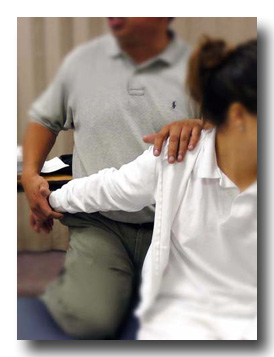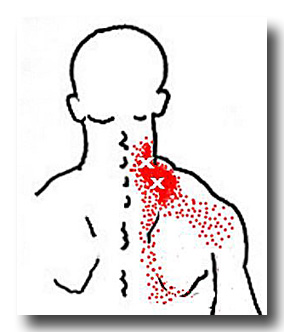|
Integrative Massage
“The end of the massage routine”
What causes pain?
Research shows that soft tissue pain results from one or a combination of the
following perpetuating factors:
- Ischemia – Lack of blood & oxygen caused by muscle tightness
- Trigger Points – Areas of hyper-irritability which cause referred pain or
sensations to other body regions independent of muscle innervation.
- Nerve Entrapment or Compression – pressure on a nerve by either soft tissue or
hard tissue (bone).
- Nutrition – Inadequate nutrients or the absorption of substances that are
harmful, irritating or stimulating to the nervous system, such as caffeine,
sugars, alcohol or nicotine.
- Emotional Wellbeing – Stress management
- Postural Distortion – when the body’s alignment, in reference to gravity,
deviates from its most efficient, ideal position.
|
 |
Integrative massage is a “best of” approach that we feel is most beneficial
for those clients riddled with muscular tension, chronic pain and trauma (such
as car accident or sporting injury). This system merges our skills in Orthopedic
Massage (identifying and treating conditions involving the joints, muscles,
nerves and fascia of the body) and Medical Massage (identifying and treating
pathological conditions such as Fibromyalgia, MS, Parkinson, Insomnia,
Depression).
It is also sensitive to the emotional and energetic aspects of our
clients by means of Cranial and Energy Work. It addresses any problems or
concerns by assessing, treating and reassessing any unusual or uncomfortable
patterns of movement. Integrative Massage is best when used regularly as a
preventative and maintenance measure.
Orthopedic Massage focuses on rehabilitation of soft tissue pain &
impairment. Although, typically geared to athletes and chronic pain sufferers,
we recommend it for individuals hoping to improve or maintain their overall
health and well-being.
The techniques used in this Orthopedic Massage are Orthopedic Assessment &
Evaluation, Connective Tissue Massage,
Neuromuscular Therapy (NMT), Sports Massage, Scar Tissue Mobilization (Deep
Transverse Friction), Facilitated Stretching & Neuromuscular Re-education, as
well as client home care protocols. We do not adhere to a rigid set of
techniques or routine, we administer our treatment depending on the needs of the
client, which usually differ from one appointment to the next.
 |
Neuromuscular therapy (NMT), sometimes referred to as (Myofascial) Trigger
Point (TrP) Therapy, is one of the most sought after modalities in massage
therapy. It is based on the research of
Janet Travell physician to two American
Presidents. She defined myofascial trigger points as:
Trigger Point - An area of hyperirritability in tissue that, when compressed,
is locally tender and, if sufficiently hypersensitive, gives rise to referred
pain and tenderness, and sometimes to referred autonomic phenomena and
distortion of proprioception.1
Neuromuscular - A term describing the interaction between nervous system
control of the muscles and the response of the muscles to the nerve signals¹.
|
These areas can be felt as small areas of tightness within muscles; creating
tight bands or ‘knots’ formed by the contracted muscle fibers. These TrPs cause
discomfort when pressed. Their defining feature is their ability to refer pains
to distant sites. With manual intervention by a skilled therapist, the TrPs can
be reduced and often eliminated; restoring balance and function to the body.
The technique Travell recommended in her writings was Trigger Point Therapy.
It is an anatomically oriented, deep tissue, pressure point technique used to
relieve pain and increase mobility. Trigger-point therapy is based on
neuromuscular stress points and uses deep digital sustained pressure to
accomplish the desired result of pain relief.
“Obsession with Posture”
Posture is how our body aligns, from head to toe, and how we resist the
incessant pull of gravity. From the moment we are born, gravity binds us. Once
the body acquires negative patterns or poor posture, it will slowly and
insidiously stress the joints, create tension in muscles and depletes the body’s
energy. The stress placed on the muscles, fascia and nervous system from poor
alignment lead to chronic aches and pains.
| However, because muscles and its associated fascia are the only source of
voluntary movement in the body, all is not lost. Good posture not only reverses
the effects of bad posture but creates a solid foundation, a balanced place,
from which to create more fluid movements. One does not move with fluidity if
one cannot be efficient in stillness. From stillness comes flow. How does one
become more fluid? Awareness. That is the first step.
This is what Integrative Massage gives you. The moment you arise
from your session, you are immediately aware of your body; your hips
feel looser, your shoulders feel less tense, your breath is fuller
and you can think clearer. |
 |
When
your muscles align your bones in an orderly and efficient manner, your body
expends less effort combating the force of gravity. In addition to awareness,
Integrative Massage will release chronically overused, tight and short muscles.
It will also encourage and balance muscles that are overstretched, spastic and
weak. The result is a more cognizant individual with economical, refined and
pain-free patterns of movement.
Medical Massage is a modality that requires additional education from the
licensed massage practitioner. The massage practitioner must have in depth
knowledge of anatomy, physiology, pathology and pharmacology. This modality has
evolved as a response to the ever-changing expectations of clients who now
perceive massage as a health care modality rather than an occasional indulgence.
Knowledgeable and competent therapists are now doing medical massage in cancer
wards, hospice centers, senior citizen homes, drug rehab clinics, etc. Medical
massage is administered in one of three forms. As a preventative measure,
designed to maintain and prevent deterioration of the health of the patient. Or
as an enhancement, working alongside health care providers to resolve and cure
the patient from illness. Or as a palliative measure, with the aim of reducing
uncomfortable or undesirable side effects of the disease, such as pain, anxiety
and stress.
¹ Janet Travell and David Simmons. Myofascial Pain & Dysfunction-The Trigger
Point Manual, 2nd edition. LWW, 1998.
|
